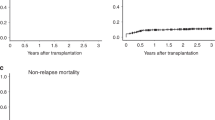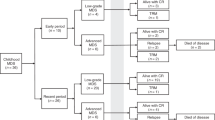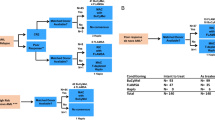Abstract
Juvenile myelomonocytic leukemia (JMML) is a life-threatening myeloproliferative neoplasm. This multicenter study evaluated the characteristics, outcomes, and prognostic factors of allogeneic hematopoietic cell transplantation (HCT) in recipients with JMML who were diagnosed between 2000 and 2019 in Korea. Sixty-eight patients were retrospectively enrolled—28 patients (41.2%) received HCT during 2000–2010 and 40 patients (58.8%) during 2011–2020. The proportion of familial mismatched donors increased from 3.6 to 37.5%. The most common conditioning therapy was changed from Busulfan/Cyclophosphamide-based to Busulfan/Fludarabine-based therapy. The 5-year probabilities of event-free survival (EFS) and overall survival (OS) were 52.6% and 62.3%, respectively. The 5-year incidence of transplant-related mortality was 30.1%. Multivariate analysis revealed that the proportion of hemoglobin F ≥ 40%, abnormal cytogenetics, and matched sibling donors were independent risk factors for a higher relapse rate. Patients whose donor chimerism was below 99% had a significantly higher relapse rate. Better OS and lower treatment-related mortality were observed in patients with chronic graft-versus-host disease (GVHD), whereas grade III or IV acute GVHD was associated with worse EFS. In conclusion, the number of transplant increased along with the increase in alternative donor transplants, nevertheless, similar results were maintained. Alternative donor transplantation should be encouraged.
This is a preview of subscription content, access via your institution
Access options
Subscribe to this journal
Receive 12 print issues and online access
$259.00 per year
only $21.58 per issue
Buy this article
- Purchase on Springer Link
- Instant access to full article PDF
Prices may be subject to local taxes which are calculated during checkout




Similar content being viewed by others
Data availability
All the collected medical information was stored in the Internet-based Clinical Research and Trial Management System of the Korea Disease Control and Prevention Agency. The data that support the findings of this study are available from the corresponding author upon reasonable request.
References
Stieglitz E, Mazor T, Olshen AB, Geng H, Gelston LC, Akutagawa J, et al. Genome-wide DNA methylation is predictive of outcome in juvenile myelomonocytic leukemia. Nat Commun. 2017;8:2127.
Locatelli F, Algeri M, Merli P, Strocchio L. Novel approaches to diagnosis and treatment of Juvenile Myelomonocytic Leukemia. Expert Rev Hematol. 2018;11:129–43.
Niemeyer CM, Flotho C. Juvenile myelomonocytic leukemia: who’s the driver at the wheel? Blood 2019;133:1060–70.
Sanders JE, Buckner CD, Stewart P, Thomas ED. Successful treatment of juvenile chronic granulocytic leukemia with marrow transplantation. Pediatrics 1979;63:44–6.
Flotho C, Sommer S, Lübbert M. DNA-hypomethylating agents as epigenetic therapy before and after allogeneic hematopoietic stem cell transplantation in myelodysplastic syndromes and juvenile myelomonocytic leukemia. Semin Cancer Biol. 2018;51:68–79.
Locatelli F, Nöllke P, Zecca M, Korthof E, Lanino E, Peters C, et al. Hematopoietic stem cell transplantation (HSCT) in children with juvenile myelomonocytic leukemia (JMML): results of the EWOG-MDS/EBMT trial. Blood 2005;105:410–9.
Park HD, Lee SH, Sung KW, Koo HH, Jung NG, Cho B, et al. Gene mutations in the Ras pathway and the prognostic implication in Korean patients with juvenile myelomonocytic leukemia. Ann Hematol. 2012;91:511–7.
Przepiorka D, Weisdorf D, Martin P, Klingemann HG, Beatty P, Hows J, et al. 1994 Consensus Conference on Acute GVHD Grading. Bone Marrow Transpl. 1995;15:825–8.
Jagasia MH, Greinix HT, Arora M, Williams KM, Wolff D, Cowen EW, et al. National Institutes of Health Consensus Development Project on Criteria for Clinical Trials in Chronic Graft-versus-Host Disease: I. The 2014 Diagnosis and Staging Working Group report. Biol Blood Marrow Transpl. 2015;21:389–401.e1.
Chan RJ, Cooper T, Kratz CP, Weiss B, Loh ML. Juvenile myelomonocytic leukemia: a report from the 2nd International JMML Symposium. Leuk Res. 2009;33:355–62.
Tüfekçi Ö, Koçak Ü, Kaya Z, Yenicesu İ, Albayrak C, Albayrak D, et al. Juvenile myelomonocytic leukemia in Turkey: a retrospective analysis of sixty-five patients. Turk J Haematol. 2018;35:27–34.
Niemeyer CM, Arico M, Basso G, Biondi A, Cantu Rajnoldi A, Creutzig U, et al. Chronic myelomonocytic leukemia in childhood: a retrospective analysis of 110 cases. European Working Group on Myelodysplastic Syndromes in Childhood (EWOG-MDS). Blood 1997;89:3534–43.
Manabe A, Okamura J, Yumura-Yagi K, Akiyama Y, Sako M, Uchiyama H, et al. Allogeneic hematopoietic stem cell transplantation for 27 children with juvenile myelomonocytic leukemia diagnosed based on the criteria of the International JMML Working Group. Leukemia 2002;16:645–9.
Korthof ET, Snijder PP, de Graaff AA, Lankester AC, Bredius RG, Ball LM, et al. Allogeneic bone marrow transplantation for juvenile myelomonocytic leukemia: a single center experience of 23 patients. Bone Marrow Transpl. 2005;35:455–61.
Stieglitz E, Ward AF, Gerbing RB, Alonzo TA, Arceci RJ, Liu YL, et al. Phase II/III trial of a pre-transplant farnesyl transferase inhibitor in juvenile myelomonocytic leukemia: a report from the Children’s Oncology Group. Pediatr Blood Cancer. 2015;62:629–36.
Helsmoortel HH, Bresolin S, Lammens T, Cavé H, Noellke P, Caye A, et al. LIN28B overexpression defines a novel fetal-like subgroup of juvenile myelomonocytic leukemia. Blood 2016;127:1163–72.
Olk-Batz C, Poetsch AR, Nöllke P, Claus R, Zucknick M, Sandrock I, et al. Aberrant DNA methylation characterizes juvenile myelomonocytic leukemia with poor outcome. Blood 2011;117:4871–80.
Yoshida N, Sakaguchi H, Yabe M, Hasegawa D, Hama A, Hasegawa D, et al. Clinical Outcomes after Allogeneic Hematopoietic Stem Cell Transplantation in Children with Juvenile Myelomonocytic Leukemia: A Report from the Japan Society for Hematopoietic Cell Transplantation. Biol Blood Marrow Transpl. 2020;26:902–10.
Niemeyer CM, Flotho C, Lipka DB, Starý J, Rössig C, Baruchel A, et al. Response to upfront azacitidine in juvenile myelomonocytic leukemia in the AZA-JMML-001 trial. Blood Adv. 2021;5:2901–8.
Niemeyer CM, Loh ML, Cseh A, Cooper T, Dvorak CC, Chan R, et al. Criteria for evaluating response and outcome in clinical trials for children with juvenile myelomonocytic leukemia. Haematologica 2015;100:17–22.
Inagaki J, Fukano R, Nishikawa T, Nakashima K, Sawa D, Ito N, et al. Outcomes of immunological interventions for mixed chimerism following allogeneic stem cell transplantation in children with juvenile myelomonocytic leukemia. Pediatr Blood Cancer. 2013;60:116–20.
Yoshimi A, Niemeyer CM, Bohmer V, Duffner U, Strahm B, Kreyenberg H, et al. Chimaerism analyses and subsequent immunological intervention after stem cell transplantation in patients with juvenile myelomonocytic leukaemia. Br J Haematol. 2005;129:542–9.
Matsuda K, Shimada A, Yoshida N, Ogawa A, Watanabe A, Yajima S, et al. Spontaneous improvement of hematologic abnormalities in patients having juvenile myelomonocytic leukemia with specific RAS mutations. Blood 2007;109:5477–80.
Stieglitz E, Taylor-Weiner AN, Chang TY, Gelston LC, Wang YD, Mazor T, et al. The genomic landscape of juvenile myelomonocytic leukemia. Nat Genet. 2015;47:1326–33.
Yabe M, Ohtsuka Y, Watanabe K, Inagaki J, Yoshida N, Sakashita K, et al. Transplantation for juvenile myelomonocytic leukemia: a retrospective study of 30 children treated with a regimen of busulfan, fludarabine, and melphalan. Int J Hematol. 2015;101:184–90.
Sakashita K, Matsuda K, Koike K. Diagnosis and treatment of juvenile myelomonocytic leukemia. Pediatr Int. 2016;58:681–90.
Locatelli F, Niemeyer C, Angelucci E, Bender-Götze C, Burdach S, Ebell W, et al. Allogeneic bone marrow transplantation for chronic myelomonocytic leukemia in childhood: a report from the European Working Group on Myelodysplastic Syndrome in Childhood. J Clin Oncol. 1997;15:566–73.
Dvorak CC, Satwani P, Stieglitz E, Cairo MS, Dang H, Pei Q, et al. Disease burden and conditioning regimens in ASCT1221, a randomized phase II trial in children with juvenile myelomonocytic leukemia: A Children’s Oncology Group study. Pediatr Blood Cancer. 2018;65:e27034.
Locatelli F, Crotta A, Ruggeri A, Eapen M, Wagner JE, Macmillan ML, et al. Analysis of risk factors influencing outcomes after cord blood transplantation in children with juvenile myelomonocytic leukemia: a EUROCORD, EBMT, EWOG-MDS, CIBMTR study. Blood 2013;122:2135–41.
Acknowledgements
This study was supported by a grant from the Korea Childhood Leukemia Foundation and the Korean Pediatric Hematology-Oncology Group (2020). We also thank the Korea Disease Control and Prevention Agency for providing the Internet-based Clinical Research and Trial Management System for storing medical information online.
Author information
Authors and Affiliations
Contributions
BC, HJK, HK, YTL, and KHY designed this study. ESY, SKK, HYJ, JWL, BKK, HJB, EJY, WKA, SMH, SKP, and ESY supported data collection. ESY analyzed the data. ESY, SKK, and KHY drafted the original paper. All authors have reviewed and edited the paper. KHY supervised the study.
Corresponding author
Ethics declarations
Competing interests
The authors declare no competing interests.
Additional information
Publisher’s note Springer Nature remains neutral with regard to jurisdictional claims in published maps and institutional affiliations.
Supplementary information
Rights and permissions
Springer Nature or its licensor holds exclusive rights to this article under a publishing agreement with the author(s) or other rightsholder(s); author self-archiving of the accepted manuscript version of this article is solely governed by the terms of such publishing agreement and applicable law.
About this article
Cite this article
Yi, E.S., Kim, S.K., Ju, H.Y. et al. Allogeneic hematopoietic cell transplantation in patients with juvenile myelomonocytic leukemia in Korea: a report of the Korean Pediatric Hematology-Oncology Group. Bone Marrow Transplant 58, 20–29 (2023). https://doi.org/10.1038/s41409-022-01826-z
Received:
Revised:
Accepted:
Published:
Issue Date:
DOI: https://doi.org/10.1038/s41409-022-01826-z



